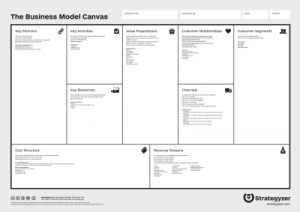#PKMChat 2016-05-18 Cocreating a PKM canvas
By Bruno Winck on Thursday, May 12th, 2016 in #PKMChat, ChatTopic. 7 Comments
Time: New York Wed, May 18th, 4 PM ET, Paris 10 PM CET, Sydney Thu, May 19th 6 AM AEDT
Click for your local time- add to calendar - Go to chat main pageHashtag: #PKMChat
Dedicated Hosts: @pkmchat
Moderators: @brunowinck, @kneaver
Questions will come from @pkmchat, you may want to reply to @pkmchat to prevent your tweets to disturb your followers.
Venue: Twitter, your favorite tool
Dress Code: GIFs, Memes and pancakes are OK
See you there!
What would look like a BMC canva dedicated for PKM?
You surely saw and read about Business Model Canvas. It has been reused everywhere for different applications like planning meeting, designing learning whatever. In many cases people didn’t take the care to fully understand the spirit of it and how it applies to startup business models. This is because they rarely have the startup experience which I can share. I complemented this experience with formal training with 2 MOOCs, several reading. Lets’ start from this reference: https://en.wikipedia.org/wiki/Business_Model_Canvas Once of the key application of the BMC is in Lean Startup. See https://leanstack.com/why-lean-canvas/ . Should we think the PKM canva as a way toward Lean PKM? Interesting perspective.
Once of the key application of the BMC is in Lean Startup. See https://leanstack.com/why-lean-canvas/ . Should we think the PKM canva as a way toward Lean PKM? Interesting perspective.
The canvas is a learning tool.
It’s not a fancy form for project management or yet another SWOT layout. The goal of the BMC is to group under on page all the key assumptions made for a long term project with upmost importance. The key benefit is that’s easy to update, stays on a single piece of paper and embed the logical of causes and influences of choice we do. It makes goals visible and related to assumptions we did. it leads long term action: that’s all good for a PKM plan. It’s popular and trendy, that’s good too. Everything that can make PKM easier and funnier is welcome.The canva embed a logic
At the center of the canvas, neither left or right we should place some key definition. A goal? a problem statement (I want to pivot my career), a purpose? Something hold in a tagline, a slogan and can be cite again and again. It’s important that it includes a why and a perspective of the benefits. So “learn coding” is not going to be sufficient. A list of skills either. This block is at the highest position, sticked to the sky. At the bottom two large blocks anchored in the ground. Those are the reality checks. On left (left will always be the past) the costs in money, time, efforts. On right the resources we could use ( a grant, a leave, a redundancy gift). order by likeliness and importance. Around the central block could be the SWOT forces, or the key partners, sources, actions. it could key metrics, a list of people we want to gain knowledge, support from (PLN). That’s going to be the heart of our debate during this chat. The central block is the reflective thinking area. At the very left a column is where you come from. For a startup the problem statement, the key problem you want to address. The canva progress from left to right. If you see it like a recipe the left columns are the ingredients you have for sure. This column don’t need to be negative, it could include a realistic assessments of what one possess already. The assumptions hidden here are completeness and being realistic in describing the current state and needs. At the very right are the outcome. It could be like a vision board of how you will become, how you will be seen if the execution of the plan went well. The key of this bloc is to list benefits, features, capabilities with the underneath assumption that someone is willing to be interested by them. The whole design is also a way to share quickly and get feedback, ideas, suggestion from others on our plans. As such it’s a great #WOL tool.What’s the topic?
I’m staying voluntarily allusive in what is in each cell. The goal is to discuss and gather various viewpoints not to impose a solution. You can download an example of Canva here and try how you would arrange your PKM plan for yourself before the chat https://canvanizer.com/downloads/business_model_canvas_poster.pdf See you on Facebook for a prechat slow conversation. PKMChat being about Personal Knowledge Management encompass Knowledge lifecycle in general. Our first chat was about learning, acquiring Knowledge. Our second is about sharing it. Week after weeks we will switch from one end of the lifecycle to another while exploring all the channels that could be used: social, formal, writing, videos. Feel free to suggest topics by tweeting to @pkmchat.TBC
Links:
Links on Diigo #PKMChat group with TBC tag https://groups.diigo.com/group/pkmchat/content/tag/TBC TBC
Questions:
- Q1: TBC
- Q2: TBC
- Q3: TBC
- Q4: TBC
- Q5: TBC
- NB: Questions are subject to change without notice.
Let's continue the discussion, join our Group on Facebook